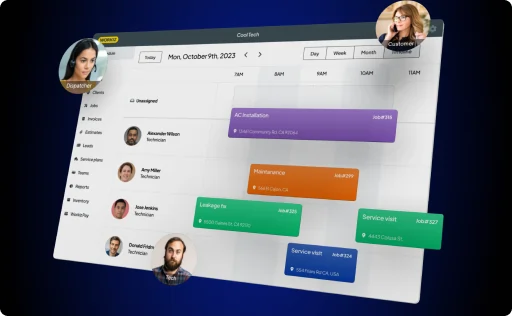Listen,
Trade jobs are currently facing a significant labor shortage! In the United States alone, over 200K positions are looking for trade job experts.
But that’s not the only problem.
The fact that there are way too many jobs and few professionals to fill the position also means that the service is costlier (with increased demand, of course).
As for the plumbing industry, what can you do?
Here’s the answer! You can make great plumbers instead of looking for experts to fill plumber jobs. We call it the ‘DIY Plumbing Process,’ where you will save costs and evade the shortage by training your employees.
According to the Bureau of Labor Statistics, the employment of plumbers is projected to grow 14% from 2019 to 2029 — much faster than the average for all occupations. So, when you invest in employee training, you can also build a skilled and loyal workforce, reduce turnover, and ensure the long-term success of your plumbing business.
It’s a win-win-WIN!
Ready to see just how you can do all these? Keep reading…
Understanding the plumber shortage crisis
A plumber shortage simply means that there aren’t enough plumbers to fill the plumbing jobs available. In other words, the supply is much less than the demand.
But why is this? Is being a plumber hard? Is that why there aren’t so many skilled plumbers to take on the job? Or is it the money?
The answer is: Not necessarily.
However, some concrete factors have been discovered to be the reason for the shortage:
Retiring skilled workers and aging workforce
While the two may differ, they go hand-in-hand. Just think about it: how many young plumbers have you seen? They may be in their mid-fifties or more if they are not old and gray. If you doubt this, ask yourself how many children you’ve heard want to grow up to be a plumber. There are also figures to back this up with over 50% of plumbers stated to be above 41 years old. That also means over half of America’s skilled professionals are nearing retirement. Now, the question is: who will take over?
Lack of knowledge in technology and advanced equipment
Remember that question — Is plumbing hard? Well, the technology and equipment are complex to use. Therefore, understanding the complexities of modern plumbing, such as varying installation codes and materials, will pose challenges for inexperienced workers, hence the shortage
The unavailability of school programs for training aspiring plumbers
The lack of funding for training opportunities in school programs and apprenticeships also has a big hand in the shortage. It’s also what has got children and teenagers thinking; “is plumbing a good career?”
The negative stigma associated with pursuing a plumbing career
Similar to the last point, most people are not convinced to pursue a career in plumbing because of the negative stigma surrounding the work and the average plumber’s salary.
The decline in family business traditions contributes to the need for more skilled plumbers. Finally, family business ties in the plumbing industry are less prevalent than in the past, leading to a loss of generational knowledge and expertise.
Fortunately, you can bypass the shortage and find your own employees through training. But why not an external training, though?
The benefits of training employees in-house
In-house training isn’t just about teaching stuff in the company they’ll be working for. It’s about empowering your team with the specific skills they need to excel in YOUR workplace. You won’t waste time on all the generals; you’ll be specific about what your company needs from them and how they can execute perfectly.
Here are other reasons you should give it a go:
Cost-effectiveness
Training a whole crew can get pricey externally. You’d have to consider transportation, registration, and so much more. In-house, you can leverage existing resources (like a tech-savvy employee that’s already in the business) and avoid the travel costs.
Tailor-made magic
Another thing about external training services is that they’ll teach everything! Now, generic training programs are nice; however, they can’t compete with something designed to meet your company’s unique needs. When you focus on in-house training, the training will be set on the nitty-gritty of your equipment, software, or processes — leading to better efficiency of your team members.
Convenience is king
Again, you won’t have to worry about trying to fit training into everyone’s schedule. In-house lets you train on-site, during off-peak hours, or even break it down into bite-sized chunks while on the job. (Not to mention that you can save time!)
Communication champions
In-house training fosters a sense of teamwork, especially since employees from different departments can learn from each other. This also improves communication and collaboration across the board.
But then again, it is not as easy as it may seem. If you don’t have a proper strategy, what may seem like a solution may again become a problem. For instance, if you think about this: “How long does it take to be a plumber?” You’ll recall that you may spend a long time training, and your business will suffer.
So, how can you avoid this pitfall?
Steps to training a new plumbing employee
According to a recent Barclays survey, 47% of businesses like yours have no clear strategy. Out of this 47%, over 40% of them ended up ‘flunking’ their goal. That’s to show that, above all, you need a good strategy.
So, what is the strategy?
Step 1: Theory
Before you show them the technologies to be used, lay the foundation. Let them know plumbing can involve hazards like flammable materials, confined spaces, and electrical components. So, start with comprehensive safety training, including proper use of personal protective equipment (PPE) and emergency procedures. Also, teach each of them the local plumbing codes and regulations.
In this step, you should also take the time to introduce the core principles of plumbing systems such as water pressure, drainage principles, fixture types, and common plumbing materials (think pipes, valves, and fittings).
Equip them with the knowledge to diagnose common plumbing problems which includes interpreting symptoms like leaks, clogs, and low water pressure.
Step 2: Practical
After the class is over, it’s time for the tools! Here, you can have them come to a job and watch as the task is being done, or they can carry out some little tasks by themselves on site. That way, you have left the classroom and have moved to a site where jobs can begin. Two great examples of minor tasks are letting them send out estimates and invoices to customers and engage in some customer communication.
While you’re at it, familiarize them with the essential tools of the trade – pipe cutters, wrenches, plungers, snake drains, and soldering equipment. Practice safe handling and proper use of each tool. Also, set up practice scenarios with mock plumbing setups. This allows trainees to apply their knowledge, make mistakes in a safe environment, and gain confidence in performing basic repairs.
Step 3: Watch & learn
In one word, take them out! Pair them with seasoned plumbers on real job sites. That will allow them to observe professional techniques, customer interaction, and problem-solving in action. Don’t stop them from asking questions including intimidating questions like: “do plumbers make good money?” or “how much does the average plumber make?”
The more they understand the “why” behind what they’re doing, the faster they’ll grasp the bigger picture.
Step 4: Time to fly
As they progress, allow them to tackle smaller jobs under your supervision (even for customers). When you do this, you’ll help them build confidence and while they hone their skills in a controlled setting.
Also, don’t stop here. Remember that learning never stops. So, as the plumbing field is constantly evolving with new technologies and materials, encourage your newly minted plumbers to continue learning through industry publications, online resources, and attending relevant workshops.
Saving costs through employee training programs
Now that you already know the steps to take, let’s talk you through how you can save costs with a smart strategy. While following the steps outlined above, you should also take note of a few things so that you can save time, cost, and resources.
What are these things to note:
Don’t just begin to train, make a list of gaps you want to fill. What are the specific needs and goals of your company? What do you need every employee to know? When you use this targeted approach, you’ll ensure you’re getting the most out of your training dollars.
Don’t leave the training for just yourself to do! That’s why you have a business with other employees. Except if you’re just starting out and you have no other team member, it’s advisable to utilize the expertise of your other staff to train new employees. Not only will this be cost-effective, but you’ll also be able to help your employee improve their knowledge. To do this effectively, you can make use of plumbing software tools like Workiz to help manage your training process and operations for easier monitoring and analytics and easy scheduling.
Make use of all the latest technology at your disposal from software products like the Workiz we mentioned, to online learning platforms, eLearning modules, and even microlearning resources. When you embrace these technologies, you’ll be signing up for flexibility, accessibility, and cost-effective ways to deliver essential training content.
Don’t just train and forget! Track the impact of your training programs on employee performance, productivity, and error rates. This data can help you refine your approach and demonstrate the program’s value. To do this effectively, you can make use of Workiz’s inventory tool which helps you track, monitor, and record data all from one platform.
Investing in the future: Retaining trained plumbing staff
Remember when we mentioned the two problems the plumbing industry is facing: the shortage of skilled workers and the rising demand for their services.
So, here’s the question you should answer: “how do you keep the talented plumbers you’ve trained from jumping ship to the next company?”
Here’s how to invest in your plumbing staff and create a loyalty loop that benefits everyone!
Provide a competitive compensation
Remember that question regarding plumber yearly salary? Well, conduct your research to ensure that your plumbers are compensated fairly within the industry standard. In addition to this, offer a comprehensive benefits package that caters to their needs. From health insurance, retirement plans, and paid time off, these are all options you can invest in.
Be interested in their career development & growth
Just because you have trained them to be plumbers does not mean you should stop there. Don’t let their skills become stagnant. Invest in ongoing training programs that introduce new technologies, advanced techniques, and opportunities for specialization. You can also provide mentorship opportunities with senior plumbers and create pathways for career advancement.
Give them the respect they deserve
Studies show that a positive work environment increases productivity by 12%, employee satisfaction by 89% and business profitability by 21%. That means there’s just too much to gain by fostering a culture of respect and appreciation. Therefore, take the time to recognize your teams’ achievements, celebrate their successes, and create a team atmosphere where they feel valued.
Maintain open communication channels
Encourage regular feedback from your plumbers to understand their needs, concerns, and suggestions for improvement. At the same time, be transparent about company goals, challenges, and decision-making processes. This builds trust and fosters a sense of ownership within the team.
Finally, invest in their wellbeing
It’s not just about their career growth. Also, prioritize safety by providing proper training, personal protective equipment (PPE), and a focus on safe work practices. Besides the physical state, also, acknowledge the mental strain that can come with demanding jobs and offer resources for mental health support.
By doing these, you would not only combat the shortage of skilled help, but you’ll be able to escape the need for repetitive training since you’ll be retaining your employees.

Benjamin Franklin Plumbing and Master Plumbers
Case studies: Companies successfully training plumbing employees
So, let’s talk about some real-life scenarios that will show you how many other companies are making use of this strategy to exclude themselves from the problem of labor shortage in trade jobs.
Benjamin Franklin Plumbing
Benjamin Franklin Plumbing is a plumbing company based in the United States. They offer multiple services just as every plumbing business but what makes them stand out is their franchise services. Even on their page, they have the following services listed out:
- They help owners train their workers
- They help a business continue their growth by providing new products to owner
- They ensure owners have professional marketing solutions, and so on.
In other words, they help employees grow and stay up-to-date with industry standards and challenges, hence boosting their business in the long run.
Master Plumbers in Australia
Even all the way in Australia, Master Plumbers offers a professional training and employment scheme through their Group Training Organization (GTO) called Plumbing Apprenticeships Victoria (PAV).
With PAV, they’ll recruit apprentices and place them with “host” employers to gain qualifications, skills, and hands-on experience. By doing this, they’ll be providing a range of experience in different plumbing specialties, such as water, sanitary, drainage, mechanical services, roofing, and gas services, hence, fighting against the labor shortage.












